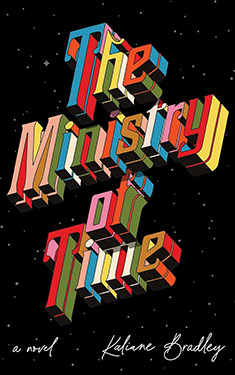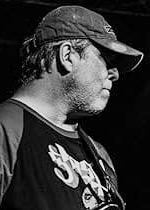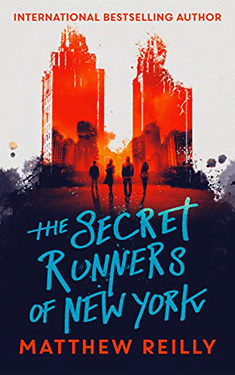The Secret Runners of New York
| Alternate Title: | The Secret Runners |
| Author: | Matthew Reilly |
| Publisher: |
Hot Key Books, 2019 |
| Series: | |
|
This book does not appear to be part of a series. If this is incorrect, and you know the name of the series to which it belongs, please let us know. |
|
| Book Type: | Novel |
| Genre: | Science-Fiction |
| Sub-Genre Tags: | |
| Awards: | |
| Lists: | |
| Links: |
|
| Avg Member Rating: |
|
|
|
|
Synopsis
Rich vs. Poor. Life vs. Death.
When Skye Rogers and her twin brother, Red, move to Manhattan, rumors of a coming global apocalypse are building. But the ultra-wealthy young elites at their prestigious school keep partying like there's no tomorrow--while the city around them starts to fall apart.
Then Skye and Red are invited to join the Secret Runners, an exclusive group that has access to horrifying truths about the future. Can that insider information save them? Or is this the only time even one-percenters can't buy their way to safety?
Excerpt
New School, New Life
It was my first day at school in a new city, but I don't think you'd find many people feeling sorry for me.
On paper, my life was the ultimate fantasy of the average American sixteen-year-old girl.
I was living in New York City on the Upper West Side, in the historic San Remo building, in an enormous apartment that overlooked Central Park. The San Remo is one of those imperious twin-towered art deco co-ops that were built in the 1930s and are now occupied by movie stars, Wall Street masters of the universe, Saudi princes, and anybody else who can afford to pay $20 million in cash for an apartment.
But as far as I saw it, my life sucked.
Wrenched from my childhood home in Memphis, I had been transplanted at the age of sixteen into the most fearsome milieu of teenage bitchiness imaginable: that of ultra-wealthy New York.
Enrolled at a new school in a new city, away from the father I loved, living with a mother I despised and a stepfather who tolerated me, I hated it. The only plus was that my twin brother, Red--ever calm and easygoing--was in it with me.
The first day of school didn't start well.
I dressed in my uniform: an utterly sexless white button-down blouse under a navy-and-green tartan dress. The white shirt was long-sleeved with stiff buttoned cuffs. A racing-green ribbon was the only hair accessory allowed. In a school as well-to-do as Monmouth, jewelry can be a serious issue--girls get competitive about this sort of thing, and it was entirely possible for a female student to wear earrings worth a few hundred thousand dollars. So all jewelry was forbidden. The only other accessory permitted was a watch.
I didn't mind the plainness of it all, or the sexlessness, for that matter. At my old school in Memphis--an all-girls school--there had been no dress code, so the student body had worn whatever they liked, and as the girls got older, every day became a fashion contest. And as hips became curvier and breasts became larger, the waistlines of jeans got lower and the necklines of tops plunged farther. In the stifling heat of the Tennessee summer, the amount of skin on display was outrageous.
One hot summer's day, as I saw two male gym teachers ogling the asses of three seventeen-year-old girls in short shorts, I overheard a female teacher say, "Are you kidding me?"
But this was not the case at The Monmouth School (never forget to include the "The"; they will correct you). It was a learning institution, and uniforms--for both boys and girls--were one of the ways it kept its students' eyes on their books and not on the opposite sex.
As I said, I didn't mind this. For my own reasons, I especially liked the long-sleeved shirt. And I always wore a watch on my left wrist: a chunky yet very practical white Casio G-Shock.
My mother, on the other hand, had all sorts of issues with the school's uniform policy.
She positioned me in front of the mirror in our entry hall and began redoing my hair from behind me. She twirled a couple of mousy brown strands down around my temples.
"Don't yank your hair back off your face like that, Skye, darling," she said. "You could be pretty, you know, if you tried a little."
I bristled inwardly, but I didn't let it show. I'd heard a thousand comments like this before.
Why don't you wear something a little more flattering?
Stop slouching, pull your shoulders back, push your little titties forward.
Eyes up, child. Honestly, how will you ever get a boy to notice you if you never look up?
And most cutting of all: You know, Skye, I really think you could stand to lose a little bit of weight.
Of course, my mom was fully made up even though it was 7:30 in the morning.
She had already been up for two hours by then, and in that time she had run six miles on her treadmill and done a hundred sit-ups and a twenty-minute mindfulness meditation. My mother was forty-five with the body of a twenty-five-year-old, and today her sleek form had been poured into a perfectly fitted Prada dress. Her long auburn hair, as always, had been professionally done, every curl and wave carefully arranged. (Our live-in maid, Rosa, in addition to being my mother's personal servant, confidante, and informer, had once been a TV makeup artist, which no doubt had secured her the job.)
Oh, and my mother wore heels, even in our apartment at that hour.
"Skye," she said, "this is a hard truth that nobody wants to admit, but you have to learn how the world judges women: it's not what is in our heads that matters. It's the package. How else do you think I won your stepfather?"
A quick little disappearing act under the table at the restaurant on your first date? I thought uncharitably. I'd overheard Mom revealing that to her best friend, Estelle, one night on the phone after she'd had a few too many cosmopolitans.
My mother, Deidre Allen (née Rogers, née Billingsley)--one-time belle of the Memphis Ladies' Auxiliary's debutante ball and second runner-up in the Miss Tennessee beauty pageant--had only a high school education to her name, but that hadn't stopped her from rising to the peak of New York society and adopting a daily ritual of shopping, lunching, yoga, and cocktails.
Thankfully, at that moment, Red came down the stairs, dressed in his Monmouth blazer, tie, and trousers, and said, "You ready, Blue?"
I loved my twin brother. His real name was Alfred, but since time immemorial everyone had called him Red. With his carelessly tousled copperish hair and his elfin face--which matched mine--he somehow managed to make his private school uniform look cool.
I don't know how he did it.
Hell, sometimes I didn't know how he and I had shared the same womb.
A bare two minutes older than me, Red was everything I was not: chill and all-but-unflappable. Nothing could rattle him. "It's that extra level of maturity I possess," he'd tease me. "Since I am a little bit older than you."
He made friends easily, effortlessly. You could throw Red into a room full of strangers, and within twenty minutes, he'd be chatting and laughing with a bunch of them.
I wished I could do that.
I liked to think I was pretty good at small talk and could get along with most people. The problem was the intro.
I was painfully shy when I met people for the first time. I just had to get to the conversation. Once there, I was actually okay; reaching it was my problem.
Blue had been my dad's nickname for me--my real dad's--as in sky blue. (I actually couldn't remember him ever using my real name.) Get it? Red and Blue. And since my dad's name was Dwight, he had loved to say, "Look at us three: Red, Dwight, and Blue!"
Dad jokes. You hate them when you hear them every day, but trust me, you sure do miss 'em when he's gone.
I said, "Ready as I'll ever be, I guess."
I yanked myself from my mother's grip and got out of there as fast as I could.
Our new school was directly on the other side of Central Park, maybe half a mile away, so Red and I walked there.
I have to admit, despite all the other things I hated about my life, I liked that walk.
Our building was on Central Park West, not far from the American Museum of Natural History, and Monmouth was on the Upper East Side, on Fifth Avenue near the Met, so we walked along the lovely tree-lined paths that swooped over and beside the ever-busy 79th Street Transverse.
At that time of the morning, it was quite delightful.
Delightful, that is, except for the crazies and the religious weirdos who had become regular sights on the sidewalks near landmarks like the Met and most of the major entrances to Central Park, holding up their signs and bibles.
The happier nutjobs wore tinfoil hats and danced around like idiots. They carried signs like:
THIS ST. PATRICK'S DAY
IS GONNA BE THE BEST ONE EVER!
YOU SHOULD HAVE ASKED HER OUT.
FORNICATE! SPEND! LOOT!
AFTER MARCH 17
IT AIN'T GONNA
MATTER ANYMORE!
The religious ones were older and more serious. They held their placards silently and stoically. Their signs were less colorful.
LUKE 21:25=26
1 JOHN 5:19
THE WHOLE WORLD LIETH IN WICKEDNESS!
AND HE SHALL DESTROY THE SINNERS! ISAIAH 13:9
THIS IS GOD'S VENGEANCE.
WELCOME TO THE RECKONING.
I didn't care much for the St. Patrick's Day stuff. It had been all over the news when that old scientist had first made his announcement a year or so ago, but March 17 was still seven months away. After the initial media fervor, people had gotten bored with it, and soon the whole thing had become just another Y2K, Comet Hale-Bopp, or 2012 apocalypse. It blew over.
Many people, like my mother, compared it to that crazy Christian dude who had convinced his followers to sell all their possessions because the world would end on May 21, 2011. When it didn't, many found themselves broke and still very much here.
And so Red and I just walked right past the ragtag group of sign waivers and entered our new school, where my own personal hell would take place.
Assembly
The Monmouth School was located inside a nineteenth-century Astor family mansion on Fifth Avenue. Above its aged stone entry arch was a coat of arms and the Latin motto Primum Semper.
First always.
That about summed it up.
Monmouth was not your standard high school.
Its students were rich. Really rich. Their parents were the kinds of people you see at White House dinners. Situated on the Upper East Side of Manhattan, overlooking Central Park, the school was one of the most exclusive high schools in America. Everyone who was anyone wanted their progeny to go there, and they did whatever it took to make that happen.
But with one of the biggest endowment funds in the country behind her, the famous headmistress of Monmouth, Ms. Constance Briggman--she has been headmistress for twenty years--could not be bought. As she put it, there were other elements that made a child "Monmouth material."
Those other elements could be anything, really, but they usually pertained not to the student but to the student's family. They might have included a sustained contribution over many years to the cultural life of New York City, or being the winner of an old and highly regarded prize (read: Nobel or Pulitzer), but in the end, one asset trumped all others.
Breeding.
When I arrived there, the school boasted four students who were direct descendants of Mayflower families and three who had ancestors who signed the Declaration of Independence.
Monmouth disdained the children of modern celebrities and the nouveaux riches. Ms. Briggman, a lifelong spinster of modest tastes who lived in a cozy apartment on the premises, delighted in turning down bribes. She had once famously declined an invitation to attend the Met Gala with a prospective parent, saying, "Why on Earth would I want to attend a function put on by a magazine?"
Her job, she maintained, was simple. It was to retain Monmouth's number-one standing in the dual worlds of education and society.
First always.
That said, there was one thing about The Monmouth School that Ms. Briggman did her very best not to talk about.
The missing girls.
Over the last two years, three students connected to the school--all girls, all new, one sophomore, one junior, one senior--had gone missing.
Just poof, gone. Without a trace.
Never to be seen again.
There was the smart girl, Trina Miller: a sophomore with a 4.3 grade point average and an exceedingly bright future. She'd disappeared in January of last year, only five months after starting at Monmouth.
Then there was Delores Barnes, the special-needs student. A gentle girl with Down syndrome, Delores had been part of the My Little Sister Program, a program that paired students at Monmouth with kids from nearby schools.
Even though it was designed to show them how fortunate they were, the students from Monmouth mocked the program relentlessly. But they did it anyway, for that all-important community service line on their college applications. Delores had been a junior and disappeared in December last year.
And finally, the most recent disappearance, that of Rebecca Taylor. Becky's disappearance had been the most shocking of all.
A vivacious and outgoing girl, Becky had become one of Monmouth's most popular students within a year of arriving. Everyone had thought she would be named Head Girl this school year. But back in March, on the night she was crowned belle of the ball at the East Side Cotillion--the most exclusive debutante ball in New York--she had disappeared.
Just vanished into the night in her snow-white debutante gown, never to return.
Alone among the missing girls, Becky had left a note--a text--saying that, overwhelmed by the pressures facing her, she had thrown herself into the river, presumably weighted down so that she would never be found.
It shocked many that a student as bubbly and popular as Becky could have been harboring suicidal thoughts. You just never know, they said. She became a lesson taught in self-esteem classes.
Of course, in all three cases, the NYPD had been called and detectives assigned. Ms. Briggman had even hired a former FBI investigator to look into the matter. The police, she said publicly, "fine public servants that they are, might not give this task the time and effort it deserves." In private, she put it another way: "Regular people use the police. We pay for, and get, a better service."
But neither the police nor the ex-FBI guy found anything that could lead them to the missing girls--no phones, no fragments of clothing, no bodies.
Not a single thing.
The FBI man investigated the possibility of kidnapping in all three cases, but those efforts also came to nothing.
It was puzzling, he said, that in this age of CCTV cameras, credit card records, and Find My iPhone, these three students could vanish from the face of the Earth.
Nasty girls from nearby schools never missed an opportunity to goad Monmouth students about it, and I had only found out about the missing-girls issue when I had casually told someone about my new school.
And as I walked under that old stone archway on my first day, I did it acutely aware that at the school where new girls go missing, I was the new girl.
The 280 students of The Monmouth School gathered in the school's theater-like auditorium, a sea of blue-and-green tartan uniforms, murmuring quietly.
Copyright © 2019 by Matthew Reilly
Reviews
There are currently no reviews for this novel. Be the first to submit one! You must be logged in to submit a review in the BookTrackr section above.
Images
No alternate cover images currently exist for this novel.



















 Full Details
Full Details






